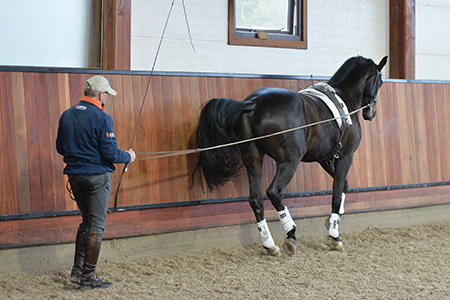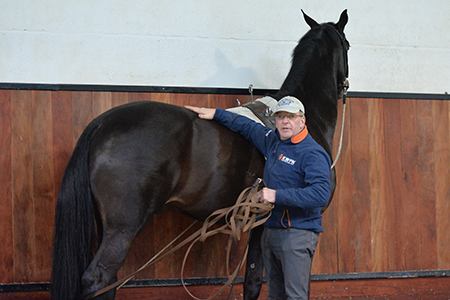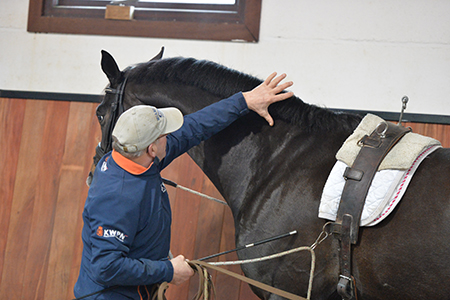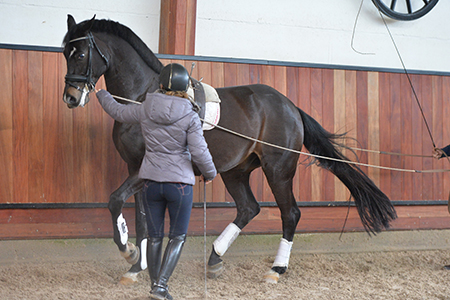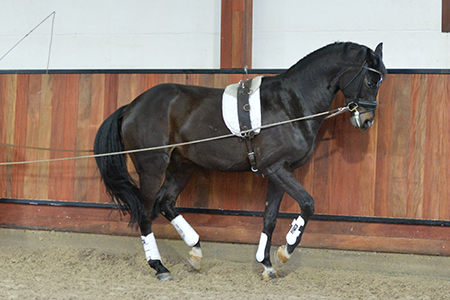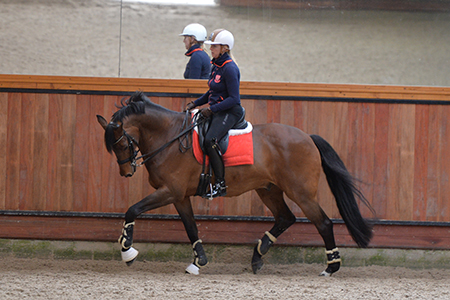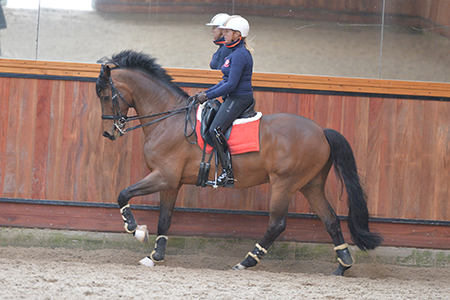All great trainers need that special rider, their ‘muse’ to make their teachings come to life, and Dutch master trainer, Johan Hamminga has found his muse in the mega-talented, Jennifer Sekreve. It was our privilege to watch Johan and Jennifer work together over two days at their training centre in one of the most beautiful parts of Holland, near the town of Elspeet.
When we arrive at the indoor on a misty spring morning, Johan is working a black stallion, by Sandro Hit out of a Gribaldi mare, in long reins. I’ve just finished writing my article on the KWPN stallion show – where we have spent the last few days – puzzling why long legs are considered so desirable, and the first thing Johan says is that the black horse’s problem is that his long legs make him weak and that Johan has had to spend a lot of time building up his loins and the strength in his back. The eight-year-old is working at Prix St Georges level but he still spends time in the long reins – especially when Johan has been away and he’s been on the walker, but not ridden for three days.
“In the beginning when I work the horse in the long reins, I start with them through the lower rings on the roller, and when he gets looser, move to the higher rings. It’s like riding a horse.”
Johan regularly stops the horse and backs him:
“You can see the problem with his long hind legs. I have to develop the loins and the back to get more engagement and bending in the hocks. On the long lines I like to go a little bit forward, a little bit back, then he takes more weight and lifts the forehand.”
Why do people keep breeding for long legs when long legs make it harder not easier to produce a dressage horse?
“In Holland we decided five years ago that the horse had to have long legs – but no, the average height from 170 to 172cm, that is enough, not 180, and not such long legs because with long legs you have a lot of injuries. The long legged horses lose their balance and they strike themselves – when the legs are a little bit shorter there is more control and more balance, and not so many injuries.”
The great advantage of Totilas was that he was very good in his mind.
I remark to Johan, that Totilas does not have very long legs, and that his sons at the licensing, looked great…
“When Totilas was three and four years old, he was a little bit high with the front legs, and the movement didn’t really come out of his shoulder, but the great advantage of Totilas was that he was very good in his mind, you could ride him in whatever system and he would still do his work. The three Totilas colts at the licensing were very good horses but he covered very good mares. The De Niro mare produced Chagall and Bretton Woods, fantastic mare, the Jazz mare (sister of Parzival) is also a fantastic mare, the Desperados mare I don’t know, but that is a good horse.”
I am reminded of the late Nuno Oliveira as Johan backs the black stallion the length of the arena
I remark that most trainers are scared of rein back – especially with short steps – for fear of getting backwards steps in the piaffe…
“In rein back the horse is bending all the joints of the hind legs, then I can make that long hind leg more elastic, more supple, and develop the muscles of the loins, and that is most important in collection because all that motor behind has to be distributed through the loins to lift up the back.”
“Going backwards is not a problem, this is just a training exercise, he has to learn to lower the croup because if they are high behind in piaffe, the mark is lower – when it gets better, when he gets stronger, we will stop doing it, and when you are sitting in the saddle, you can use your legs to keep the forwards tendency.”
Always look at your horse – what does it need?
“I do it specially for the Sandro Hit, with the Damon Hill mare, I don’t use rein back, never – I’m also scared of rein back, because the mare has so much bending and so much activity in the hind legs that we have to make her go forward, forward. Always look at your horse – what does it need? That is why I never use the word, system, for me that is not a good word, training, schooling, those are the best words to describe the training of the horse. In the classical way, you had to school a horse, and not ride it in a system. That is the trouble for many instructors, trainers, they have a system and they use that system on every horse, on every different horse. One system for every horse, that is not possible. If your work is interesting, then you have a good training scale, and a lot of training tools, then you can see, for this horse I pick up that tool, and for that horse, that tool – that is the difference, that is what makes my work so interesting, that’s what gives me a kick.”
That is the trouble for many instructors, trainers, they have a system and they use that system on every horse, on every different horse. One system for every horse, that is not possible.
The steps are super now and in such an even rhythm, and the horse is calm and relaxed immediately after the exercise.
“When there is no weight on his back, he can find his own way, and you can make it more or less. We must also work on the muscles of the neck in front of the wither so the neck can go up. I put the inside rein a little higher so I can keep the neck a little more uphill.”
Jennifer joins in, walking at the horse’s head: “It is important that I have Jen there, she can say, too long, too low, not enough through the neck. You need two people to work the horse in long reins. Now he is more through, and we can put the reins higher.”
Johan explains that he works on the half steps and the piaffe before working on the passage steps. “When you start on this collected work it is hard to keep the horse quick in the hind legs. So often in the test, you see passage where the horse gets longer and lower in the back, lots of horses have a spectacular front leg in passage, but we have to see them carrying the weight and using their whole body with a little uphill tendency. You see horses getting longer and longer in passage, then they have a difficulty with the transition, when they go to canter, they fall out and the first strides of the canter are horrible. That’s why there are so many transitions in the Grand Prix test, then you can see if the horse is ridden correctly or not.”
“If we develop more engagement and more collection in the half steps then we will have a good passage.”
One of Johan’s students, Annemieke Vincourt arrives – Annemieke has been to Australia, was back again for Dressage with the Stars. She has come to Johan today for help as she prepares to ride her first Grand Prix on her home-bred Kansas C. It’s not a competition test like we have in Australia, as Johan explains:
“In Holland we have a training Grand Prix, twice a week, there is a Grand Prix judge, you do the test, and after the test he tells you: the entrance was not straight, you have to go more forward in the passage, your pirouettes are too big, everything like that. Then you know a little bit how you will go in the real test.”
Annemieke commences her session with the horse’s nose way behind the vertical, quite unlike the way Jenifer rides her horses, but Johan explains this is the hang-over from earlier training before she started working him:
“Annemieke started training her horse in the system of rounder and deeper, and after a few years, she was in trouble. When he was five years old, he was at the World Championships at Verden, and in the training there, I helped her. Then two or three years later, she was in trouble, she called me, and asked if I could help. I said, okay, come and we will try. In the beginning the horse was rearing and kicking out, I rode him, and he went up very high, I used my whip one or two times, and it was over, we clicked – now she has been here with me for three years, and the horse is getting ready to go to the Grand Prix.”
Do you like to see the horse ridden that far behind the vertical?
“No, but it is not so easy for this horse to start in the longer frame. He is a little bit spooky, we had to train him a little bit rounder and deeper, and after about twenty minutes, then we bring him more on the vertical.”
Make him shorter from behind not shorter in the front.
“We are always working to bring the neck longer and deeper, using inside rein and inside leg to bend him, then bend him a little with the outside rein and outside leg. You have to keep working until the horse wants to follow your hands… then you see him in a better rhythm, deeper, longer, lower, and give him more rein. Then pick up the rein, collect him a little, then out… That is fine, now he collects without shortening in the frame. Now he becomes shorter, but from behind, and that’s what we had to do. Make him shorter from behind not shorter in the front.”
“We do the same exercise in the pirouettes. He has to wait on the inside leg, he has to carry more weight behind. Let him carry more weight from behind… yes, that is a small pirouette, with good steps. Let the neck fall down, let him relax in the top line.”
And every time between your exercises, a short moment of relaxation.
“And every time between your exercises, a short moment of relaxation. A few strides, then you can pick up and collect a bit more. Let him wait on your inside leg. Looser on your inside rein, give a little more inside. Inside leg, and keep the rhythm. Brave!”
“Now he is starting to use his whole topline, and you are making him stronger. When he is more relaxed in the top line, then your transitions become better and better. Now he is more forward, you can stretch the frame and you can collect the frame, it is like an accordion. Now the head is in a good position, the poll is the highest point and the nose is on the vertical and you have a real contact, he becomes more fluent and good in rhythm and he carries more weight behind.”
“Now we start with the half passes, and we change the neck position. We start by bending the horse to the left, then make him straight, then bend him, then straight, bend him, so that he is listening to the aids. He has to listen, that is very important that he is listening to your aids, and that you can change the neck position and the head position. Then he becomes looser in his top line, crossing his legs he can do so easily but he has to be loose in the whole top line. This horse has so much elasticity, he can go sideways so easily but we must make the topline better.”
After her lesson, Annemieke talked about why she trains with Johan:
“I knew Johan from my education studies with our Federation, and after that, when I took Kansy to the world championships, Johan was the team coach, so I had some lessons with him then.”
“I started coming to him regularly in 2009 when Kansas C was seven. He has always been pretty difficult, not the easiest, and 1.75 tall. He was medium level, when I came here. My problem was that if I took him to a competition and there was something in the area that was more interesting, he said, bye bye Annemieke, I am doing it my way, and he was naughty. I said to my husband, I get so tired of him because he just controls me. My husband said – you need to take another road, and see if you can find someone who is more dominant than he is – or sell him! That’s why I called Johan. The first time I came here, was in the outdoor, and he was like an angel, and the second time, there were horses on the road, and he thought, this my chance, and he went up, doing all kinds of naughty things.”
“Johan was the first one who said, give him to me, I’ll get on. You can understand, if a horse is behaving like that, and no-one is helping you, then when someone says, I am not sure I can solve it for you, but let me ride him… Johan got on and he had a little fight with Kansy and of course there are still times, but we are getting somewhere. Johan said to me then, when he was medium, he finds the work so easy he has time to look around and see things, because it is no trouble for him to do the things you ask. He said you have to find a way in your training to let him work so he gets tired in the body, then he thinks, okay I have to really work. He still has his little things, but not naughty like he was any more.”
You warmed him up very behind the vertical?
“Yeah, I must say he is very light in your hands, and in the construction of his neck, he naturally stays a bit behind the vertical. I warm him up like this also so he stretches the part in front of the saddle, and opens up the communication with me and not that he stays tight. Because when I come with my aids, and he stays tight, then it doesn’t get through, and you don’t have any communication with him. We give him a lot of time down and stretching the neck, because that is something he finds difficult. That is what is said to Johan, in the Grand Prix I need to do passage and from the passage to extended walk, and his walk is okay, but that diagonal is short for him to come out with the nose, that takes with him of time, for him to stretch out in the neck. Sometimes at home, I ride him on a light day, then I don’t pick him up, I leave him down there, I do everything with him down.”
Johan is a very directive teacher, he is in your ear a lot of the time you are riding…
“Yeah, he sees so many small things. For example, when I had the passage, he said, a little bit the shoulder to the inside, he sees that immediately, the same time as I feel it, so that is good. He rides with you, and he can also do it himself. When I have a problem, and I ask, can you get on him, he rides – and that I find important.”
Johan was equally frank in his debrief:
The horse of Annemieke, that horse was not from the beginning trained in your way, it is a bit more ‘Dutch’ looking, very behind the vertical at the start…
“In the way she was training, the horse was too short in the neck, we talked before about how the front door has to be a little open, if you close the front door and you make more activity, there comes so much pressure that he went up! And then you are in trouble… We have been working the horse more forward, and the horse is a clever horse, he has a lot of elasticity, but not so much strength from behind in his back and loins and in his hind legs, I told her, you have to ride him more forward, make him longer in the neck, so he can use his topline in a better way, and his back muscles became more relaxed, and then he can use his hind legs in a better way and then you can collect him without making him shorter in the neck.”
When they have trust, then they will do everything for you.
“Now he trusts himself and he knows he can do it. There are horses that can do all the Grand Prix movements with two fingers in their nose, but why don’t they do it? Because there is no escape for the horses, and when there is no escape, they feel trapped – but when you see there is always an escape it is different. When a horse has to do such heavy exercises, there has to be an escape and the escape is in the front, and when they have trust in that, then they will do everything for you. I think that is the most important thing in riding. As a trainer, in your tool box there are lots of tools, but it is not good to have just one system and all the horses have to fit into that system. You have a way of schooling and in that way, there are tools, and you use the right tool for that horse. The way is lengthening in the frame, relaxation in his mind, and the right training so that he becomes stronger and stronger in his muscles – then he feels good in his mind and he can do the exercises at every level… but take your time.”
Annemieke says one of the things she really likes about working with you is that you will get on her horse and ride it, is this something you like to do?
“I think all good trainers will do this. When I went to train in Hamburg at Gröhnwoldhof, Herbert Rehbein was sitting on my horse, and the horse came together and together and together, and I became smaller, and smaller, and smaller. He was such a wonderful rider, he had feeling and the horse had so much respect for him. In Germany there are more teachers, better teachers – Hinnemann, Theodorescu, Bemelmans, Koschel, Wittig, Jonny Hilberath, so many good people, I am sure there are more, and in Holland we don’t have that – how is that possible?”
You have to teach the young riders, the pony riders to the age of 30.
“The German teachers do their own job, but they all come from the same school, the same basic. That’s the most important thing for results. You have to teach the young riders, the pony riders to the age of 30, you have to learn the basics, and after that you can go a little to the left or to the right – you can ride deeper, or higher, or faster, it doesn’t matter, but first you need that basic in the riders. That is something we could do better in Holland. The German trainers are not living on their own islands, they talk and they have a lot of fun with each other, and they discuss horses and riding and training. I have a lot of respect for the Germans.”
Is that where you learnt the basics of your system?
“Perhaps, but I think you are never too old to learn, and you can learn everywhere, also in England, in Australia, France, Sweden… when you go to the international shows, then you can learn, you can look at what they are doing, and you can talk with the trainers and riders. Then you can learn, every day, every time.”
The good ways of training are always very simple…
“That’s the key, normal riding, not special tricks, just normal riding. It’s not a new system. It is very difficult when you are riding at the highest level and you want to reach the top, you need someone on the ground every day, to look and say, it’s okay or it’s not okay, too much or less. You need a person on the ground, and a good one who can tell you what to do – what’s wrong, everybody can see what’s wrong, but what is the solution? What aids are needed to make it better, that’s important.”

